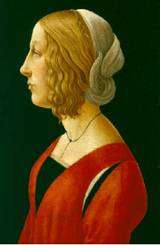Lucrezia de' Medici (1470–1553)
| Lucrezia de' Medici | |
|---|---|
 | |
| Spouse(s) | Jacopo Salviati |
|
Issue
Giovanni Salviati Lorenzo Salviati Piero Salviati Elena Salviati Baptist Salviati Maria Salviati Luisa Salviati Francesca Salviati Bernardo Salviati Alamanno Salviati | |
| Noble family |
Medici (by birth) Salviati (by marriage) |
| Father | Lorenzo de' Medici |
| Mother | Clarice Orsini |
| Born |
4 August 1470 Republic of Florence |
| Died | 15 November 1553 (aged 83) |
Lucrezia Maria Romola de' Medici (4 August 1470 – between 10 and 15 November 1553) was an Italian noblewoman, the eldest daughter of Lorenzo de' Medici and Clarice Orsini[1] and mother of Maria Salviati and Giovanni Salviati.[2] Her portrait was considered (as a newborn) as the baby Jesus in Our Lady of the Magnificat of Sandro Botticelli.
Life
She was married in February 1488 to Jacopo Salviati.[3] She brought a dowry of 2000 florins to the marriage.[4] When her brothers were exiled from Florence, she was in a difficult spot, as Jacopo was a supporter of the new rulers.[5] In August 1497 she spent 3000 ducats to support a plot to return her brother Piero to power.[5] When it failed, the men participating in the plot were executed, but the Francesco Valori, leader of Florence, could not consider harming a woman.[5] She continued to work to build support for the Medici family, including negotiating the marriage of her niece, Clarice de' Medici (1493-1528), to Filippo Strozzi the Younger against the desires of the Florentine leaders.[6] When her brother, Giuliano returned to Florence in 1512, he asked the advice of his sisters on how he should restructure the government.[7]
In March 1513, her brother became Pope Leo X, and the Medicis held days of celebrations in Florence.[8] Lucrezia and her siblings gave gifts and money to crowds outside the family palace.[8] By 1514, Pope Leo had so drained the Vatican treasuries that he pawned the papal tiara (worth 44000 ducats) to Lucrezia and her husband.[9] Lucrezia began to have public disputes with her sister-in-law, Alfonsina Orsini, who was working to elevate her son, Lorenzo to Captain General and later Duke.[10] She and her husband preferred that a group rule Florence, rather than an individual.[11] Pope Leo appointed Lucrezia's son Giovanni a Cardinal in 1517.[9] Lucrezia managed his household and office for him from 1524, particularly while he was travelling as a Papal Legate.[12] She used that influence to help promote Medici causes in Rome.[13] Lucrezia was with Pope Leo when he died.[12]
In 1527, when the Medici were again exiled from Florence, Jacopo wound up a prisoner of Charles V, Holy Roman Emperor along with Lucrezia's cousin, Pope Clement VII.[14] Lucrezia worked to gather a ransom and get her husband released.[15] She and her husband opposed Pope Clement's decision to marry their grand-niece Catherine de' Medici to the future Henry II of France, claiming that such an important Medici heir should marry within Italy.[12]
Jacopo died in 1533. Lucrezia outlived him by twenty years. Lucrezia's exact death date is unknown, but it is estimated that she died between 10th and 15th November 1553. She was 83 years old.
Patronage
In 1520, Pope Leo X asked her to help support convents in Florence.[16] She paid for a significant expansion of the convent of San Giorgio, funding new dormitories, cloisters, and workshops.[16] She built other chapels in 1530 in Rome.[16] She and Giovanni later worked together to pay for a chapel in Rome which would also serve as a resting place for the family.[16] In November 1520, she exchanged messages with Filippo Nerli and Niccolò Machiavelli about editing a biography of Alexander the Great.[17] She was a patron of Girolamo Benivieni.[18] Together, she and Benivieni petitioned her brother Pope Leo X to support their effort to bring the body of Dante Alighieri to his home town of Florence.[18]
Issue
By Salviati, she had 10 children, some of whom were of great importance to the history of Renaissance Europe:
- Cardinal Giovanni Salviati (Florence, 1490 - Ravenna, 1553)
- Lorenzo Salviati (Florence, 1492 - Ferrara, 1539), senator and patron
- Piero Salviati, patrician
- Elena Salviati (Florence, 1495 circa - Genoa, 1552), married the Marquis Pallavicino Pallavicino and second marriage to the Prince Iacopo V Appiani in Appiano
- Baptist Salviati (1498–1524)
- Maria Salviati (1499–1543), married to Giovanni dalle Bande Nere. This marriage united the main branch and Popolano branch of the Medici family. His son, Cosimo, was named to lead Florence after the death of Duke Alessandro de' Medici
- Luisa Salviati, married Sigismund de Luna and Peralta
- Francesca Salviati, married first to Piero Gualterotti and second, in 1533, to Ottaviano de' Medici and was the mother of Pope Leo XI
- Bernardo Salviati (Florence, 1505/1508 - Rome, 1568) knight of the Order of St. John of Jerusalem; served Catherine de' Medici in France; 1561 Cardinal
- Alamanno (1510–1571), patrician
Ancestry
| Ancestors of Lucrezia de' Medici (1470–1553) | |||||||||||||||||||||||||||||||||||||||||||||||||||||||||||||||||||||||||||||||||||||||||||||||||||||||||||||||||||||||||||||||||||||||||||||||||||||||||||||||||||||||||||||||||||||||||||||||||||||||||||||||||||||||||||||||||||||||||||||||||||||||||||||||||||||||||||||||||||||||||||||||||||||||||||||||||||||||||||||||||||||||||||||||||||||||||||||||||||||||||||||||||||||||||||||||||||||||||||||||||||||||||||||||||||||||||||||||||||||||||||||||||||||||||||
|---|---|---|---|---|---|---|---|---|---|---|---|---|---|---|---|---|---|---|---|---|---|---|---|---|---|---|---|---|---|---|---|---|---|---|---|---|---|---|---|---|---|---|---|---|---|---|---|---|---|---|---|---|---|---|---|---|---|---|---|---|---|---|---|---|---|---|---|---|---|---|---|---|---|---|---|---|---|---|---|---|---|---|---|---|---|---|---|---|---|---|---|---|---|---|---|---|---|---|---|---|---|---|---|---|---|---|---|---|---|---|---|---|---|---|---|---|---|---|---|---|---|---|---|---|---|---|---|---|---|---|---|---|---|---|---|---|---|---|---|---|---|---|---|---|---|---|---|---|---|---|---|---|---|---|---|---|---|---|---|---|---|---|---|---|---|---|---|---|---|---|---|---|---|---|---|---|---|---|---|---|---|---|---|---|---|---|---|---|---|---|---|---|---|---|---|---|---|---|---|---|---|---|---|---|---|---|---|---|---|---|---|---|---|---|---|---|---|---|---|---|---|---|---|---|---|---|---|---|---|---|---|---|---|---|---|---|---|---|---|---|---|---|---|---|---|---|---|---|---|---|---|---|---|---|---|---|---|---|---|---|---|---|---|---|---|---|---|---|---|---|---|---|---|---|---|---|---|---|---|---|---|---|---|---|---|---|---|---|---|---|---|---|---|---|---|---|---|---|---|---|---|---|---|---|---|---|---|---|---|---|---|---|---|---|---|---|---|---|---|---|---|---|---|---|---|---|---|---|---|---|---|---|---|---|---|---|---|---|---|---|---|---|---|---|---|---|---|---|---|---|---|---|---|---|---|---|---|---|---|---|---|---|---|---|---|---|---|---|---|---|---|---|---|---|---|---|---|---|---|---|---|---|---|---|---|---|---|---|---|---|---|---|---|---|---|---|---|---|---|---|---|---|---|---|---|---|---|---|---|---|---|---|---|---|---|---|---|---|---|---|---|---|---|---|---|---|---|---|---|---|---|---|---|---|---|---|---|---|---|---|---|---|---|---|---|---|---|---|---|---|---|---|---|---|---|---|---|---|---|
| |||||||||||||||||||||||||||||||||||||||||||||||||||||||||||||||||||||||||||||||||||||||||||||||||||||||||||||||||||||||||||||||||||||||||||||||||||||||||||||||||||||||||||||||||||||||||||||||||||||||||||||||||||||||||||||||||||||||||||||||||||||||||||||||||||||||||||||||||||||||||||||||||||||||||||||||||||||||||||||||||||||||||||||||||||||||||||||||||||||||||||||||||||||||||||||||||||||||||||||||||||||||||||||||||||||||||||||||||||||||||||||||||||||||||||
References
- ↑ Tomas 2003, p. 7.
- ↑ Tomas 2003, p. 5.
- ↑ Tomas 2003, p. 21.
- ↑ Tomas 2003, p. 20.
- 1 2 3 Tomas 2003, p. 109.
- ↑ Tomas 2003, p. 112.
- ↑ Tomas 2003, p. 115.
- 1 2 Tomas 2003, p. 126.
- 1 2 Tomas 2003, p. 130.
- ↑ Tomas 2003, p. 132-133.
- ↑ Tomas 2003, p. 133-134.
- 1 2 3 Tomas 2003, p. 141.
- ↑ Tomas 2003, p. 5,142.
- ↑ Tomas 2003, p. 116.
- ↑ Tomas 2003, p. 117.
- 1 2 3 4 Tomas 2003, p. 88.
- ↑ Tomas 2003, p. 94-95.
- 1 2 Tomas 2003, p. 95.
Sources
- Tomas, Natalie R. (2003). The Medici Women: Gender and Power in Renaissance Florence. Aldershot: Ashgate. ISBN 0754607771.